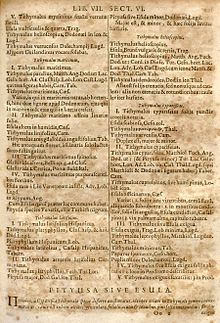Gaspard Bauhin
Gaspard Bauhin | |
|---|---|
 | |
| Born | 17 January 1560 |
| Died | 5 December 1624 (aged 64) Basel, Switzerland |
| Other names | Caspar Bauhin; Casparus Bauhinus |
| Alma mater | University of Basel (M.D., 1581) |
| Known for | Pinax theatri botanici |
| Scientific career | |
| Fields | Botany |
| Notable students | Emmanuel Stupanus |
| Author abbrev. (botany) | C.Bauhin |
Gaspard Bauhin or Caspar Bauhin (Latin: Casparus Bauhinus; 17 January 1560 – 5 December 1624), was a Swiss botanist whose Pinax theatri botanici (1623) described thousands of plants and classified them in a manner that draws comparisons to the later binomial nomenclature of Linnaeus. He was a disciple of the famous Italian physician Girolamo Mercuriale and he also worked on human anatomical nomenclature.
Bauhin described the ileocecal valve in 1588—hence the name Bauhin's Valve or Valve of Bauhin—in the preface of his first writing, De corporis humani partibus externis tractatus, hactenus non editus. Linnaeus honored the Bauhin brothers Gaspard and Jean in the genus name Bauhinia.[1]
Biography
[edit]
Jean and Gaspard were the sons of Jean Bauhin (1511–1582), a French physician who had to leave his native country on becoming a convert to Protestantism. Gaspard was born in Basel. From 1572 he studied in his hometown, Padua, Bologna, Montpellier, Paris and Tübingen. He was awarded his medical doctorate at the University of Basel in 1581, and gave private lectures in botany and anatomy. In 1581 he obtained a doctorate in medicine from the University of Basel and was in 1582 appointed to the Greek professorship at the same university, as well as in 1588 to the chair of anatomy and botany.[2] He was later made city physician (Stadtarzt), professor of the practice of medicine, rector of the university, and dean of his faculty.[3] He was rector of the university of Basel in 1592, then again in 1611 and 1619; during the second rectorate the university tried in vain to win back from the city council the freedoms of 1460, which were lost in 1532.[4]
The Pinax theatri botanici (English, Illustrated exposition of plants) is a landmark of botanical history, describing some 6,000 species and classifying them.[1] The classification system was not particularly innovative, using traditional groups such as "trees", "shrubs", and "herbs", and using other characteristics such as utilization, for instance grouping spices into the Aromata. He did correctly group grasses, legumes, and several others. His most important contribution is in the description of genera and species. He introduced many names of genera that were later adopted by Linnaeus, and remain in use.[2] For species he carefully pruned the descriptions down to as few words as possible; in many cases a single word sufficed as description, thus giving the appearance of a two-part name. However, the single-word description was still a description intended to be diagnostic, not an arbitrarily-chosen name (in the Linnaean system, many species names honor individuals, for instance).[citation needed]
In addition to Pinax Theatri Botanici, Gaspard planned another work, a Theatrum Botanicum, meant to be comprised in twelve parts folio, of which he finished three; only one, however, was published (1658), long after his death. He also gave a copious catalogue of the plants growing in the environs of Basel, its flora, and edited the works of Pietro Andrea Mattioli (1500–1577) with considerable additions.[2] His principal work on anatomy was Theatrum Anatomicum infinitis locis auctum (1592).[3]
Works
[edit]
- (as editor), Petri Andreae Matthioli Opera Omnia, Johannes König, Basel, 1574.
- Theatrum anatomicum infinitis locis auctum, ad morbos accommodatum, Basel, 1592.
- Theatrum Anatomicum, Frankfurt am Main, 1605.
- Phytopinax seu enumeratio plantarum (in Latin). Basel. 1596 – via Sebastian Henricpetri.
- Anatomica corporis virilis et muliebris historia, Leiden, 1597.
- Animadversiones in historiam generalem plantarum (in Latin). Frankfurt am Main. 1601 – via Melchior Hartmann.
- Prodromos theatri botanici (in Latin). 1620. The introduction to his projected magnum opus.
- Prodromos theatri botanici (in Latin). Basel. 1671 – via Johann König.
- Pinax theatri botanici, Basel, 1623.
- Pinax theatri botanici (in Latin). Basel. 1671 – via Johann König.
- Vivae imagines partium corporis humani (in Latin). Frankfurt am Main. 1640 – via Matthäus Merian (I).
- Theatrum Botanicum, 1658.
- Histoire des plantes de l’Europe, et des plus usitées qui viennent d’Asie, d’Afrique, & de l’Amérique […], 2 voll., Lyon, 1671.
See also
[edit]References
[edit]- ^ a b Gunn, Mary (1981). Botanical exploration of southern Africa : an illustrated history of early botanical literature on the Cape flora : biographical accounts of the leading plant collectors and their activities in southern Africa from the days of the East India Company until modern times. L. E. W. Codd. Cape Town: Published for the Botanical Research Institute by A.A. Balkema. p. 15. ISBN 0-86961-129-1. OCLC 8591273. Archived from the original on 4 October 2022. Retrieved 1 March 2021.
- ^ a b c Isely, Duane (2002). One hundred and one botanists. West Lafayette, Indiana: Purdue University Press. pp. 49–52. ISBN 1-55753-283-4. OCLC 947193619. Archived from the original on 25 November 2022. Retrieved 1 March 2021.
- ^ a b Chisholm 1911.
- ^ "Bauhin Caspar". University of Basel. Archived from the original on 28 October 2021. Retrieved 14 December 2020.
- ^ International Plant Names Index. C.Bauhin.
- This article incorporates text from a publication now in the public domain: Chisholm, Hugh, ed. (1911). "Bauhin, Gaspard". Encyclopædia Britannica. Vol. 3 (11th ed.). Cambridge University Press. p. 539.
External links
[edit]- University of Kyoto Archived 17 October 2016 at the Wayback Machine Online Pinax theatri botanici (1623)
- Online Galleries, History of Science Collections, University of Oklahoma Libraries High resolution images of works by and/or portraits of Gaspard Bauhin in .jpg and .tiff format.
- Images from Theatrum anatomicum From The College of Physicians of Philadelphia Digital Library
- Caspari (Gaspard) Bauhini, Prodromos Theatri Botanici (1620) Digitized Copy on Archive.org


